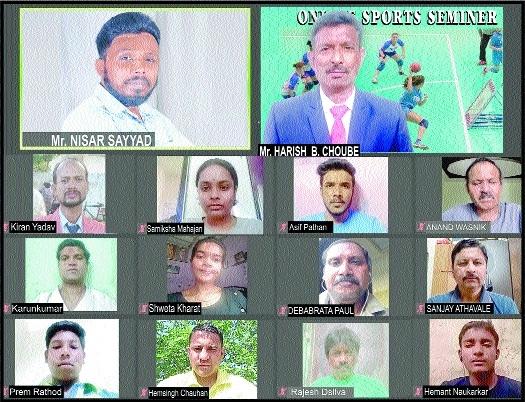Tchoukball is a contactless sport and minimises injuries
| Date :17-May-2021 |

Principal Correspondent :
The ongoing online seminar organised by Karate Budokan International (Vidarbha Region) and hosted by Kyoshi Harish B Choube, Black Belt 7th Dan, National Chief Instructor and Examiner, Karate Budokan International and National Sports Co-ordinator has once again introduced Nagpurians to a new sport— Tchoukball. The 31st session of Online Karate and Sports Seminar for Physical and Spiritual Development of Sportspersons was a session during which the amateur game was explained by Nisar Sayyad, coach of Maharashtra Tchoukball Association and a senior national level player. Tchoukball, which is an indoor sport was introduced to the world in 1970s by Swiss biologist Hermann Brandt. “Brandt was concerned about the number of injuries in sport at that time and as part of an educational study he wanted to create a sport that reduced injuries, was not aggressive between players and enabled people of all shapes, sizes, genders, cultures, and backgrounds to play together,” informed Nisar. The sport is usually played on an indoor court measuring 27 metres by 16 metres.
At each end there is a frame (a device similar to a trampoline off which the ball bounces) which measures one square metre and a semicircular D-shaped forbidden zone measuring three metres in radius. Each team can score on both ends of the court, and comprises 12 players, of whom seven may be on the court at any one time. “In order to score a point, the ball must be thrown by an attacking player, hit the frame and bounce outside the ‘D’ without being caught by the defending team,” said Nisar. As per the rules there should be no physical contact between the players. “Physical contact is prohibited, and defenders may not attempt to intercept the attacking team’s passes. Players may take three steps with the ball, hold the ball for a maximum of three seconds, and teams may not pass the ball more than three times before shooting at the frame,” explained Nisar about the playing rules of the game.
Tchoukball has become an international sport and is vastly played in Argentina, Brazil, Cameroon, China, the Czech Republic, France, Germany, Great Britain, Hong Kong, India, Italy, Indonesia, Japan, Korea, Macau, Malaysia, Niger, Pakistan, Philippines, Poland, Singapore, Spain, Switzerland, Taiwan, Thailand, Tunisia, Uruguay, the United States, and Vietnam. It is governed by the International Tchoukball Federation (FITB), which was founded in 1971. Nisar also spoke about the advantages of the game and highlighted the low risk factor. He said, “Tchoukball does not allow contact or interference between players. No position is a human target, like a quarterback or goalie. With no body contact, injuries are minimised. No player can steal the ball nor intercept a pass, instead rewarding strategy and co-operation as teams play on both offence and defence. Tchoukball is easy to play. Rules are intuitive and easily grasped. The game requires minimal equipment. It can be played indoors or outdoors and accommodates mixed team play (old/young, male/female, fit/unfit, experienced, beginner),” he said.
“No player monopolises the ball and all the players must be involved, both on offence and defence. Tchoukball requires alertness and concentration. It teaches anticipation and physics, as well as teamwork and trust,” added Nisar. Elaborating further Nisar said that the game helps in developing hand-eye co-ordination. “Tchoukball promotes hand- eye co-ordination and develops skills that enhance physical and mental output.” Speaking about the inception of the game, Nisar said that inventor of Tchoukball Brandt, believed that sports should be not only for champions, but also contribute to the creation of a better and more humane society. He designed Tchoukball to contain elements of handball (it is played with hands, and the balls used are similar), volleyball (as the defending team must prevent the ball from falling) and squash (since there is a rebound). “A player can take three steps and is not allowed to bounce the ball on the ground between these steps. When a pass is dropped or not completed (the ball touches the ground), the other team gets possession the defending team cannot hamper the attacking one. The player with the ball is only allowed to hold the ball for three seconds or less,” said Nisar. Sensei Disha Choube, 2nd Dan Black Belt, Karate Budokan International, proposed a vote of thanks.